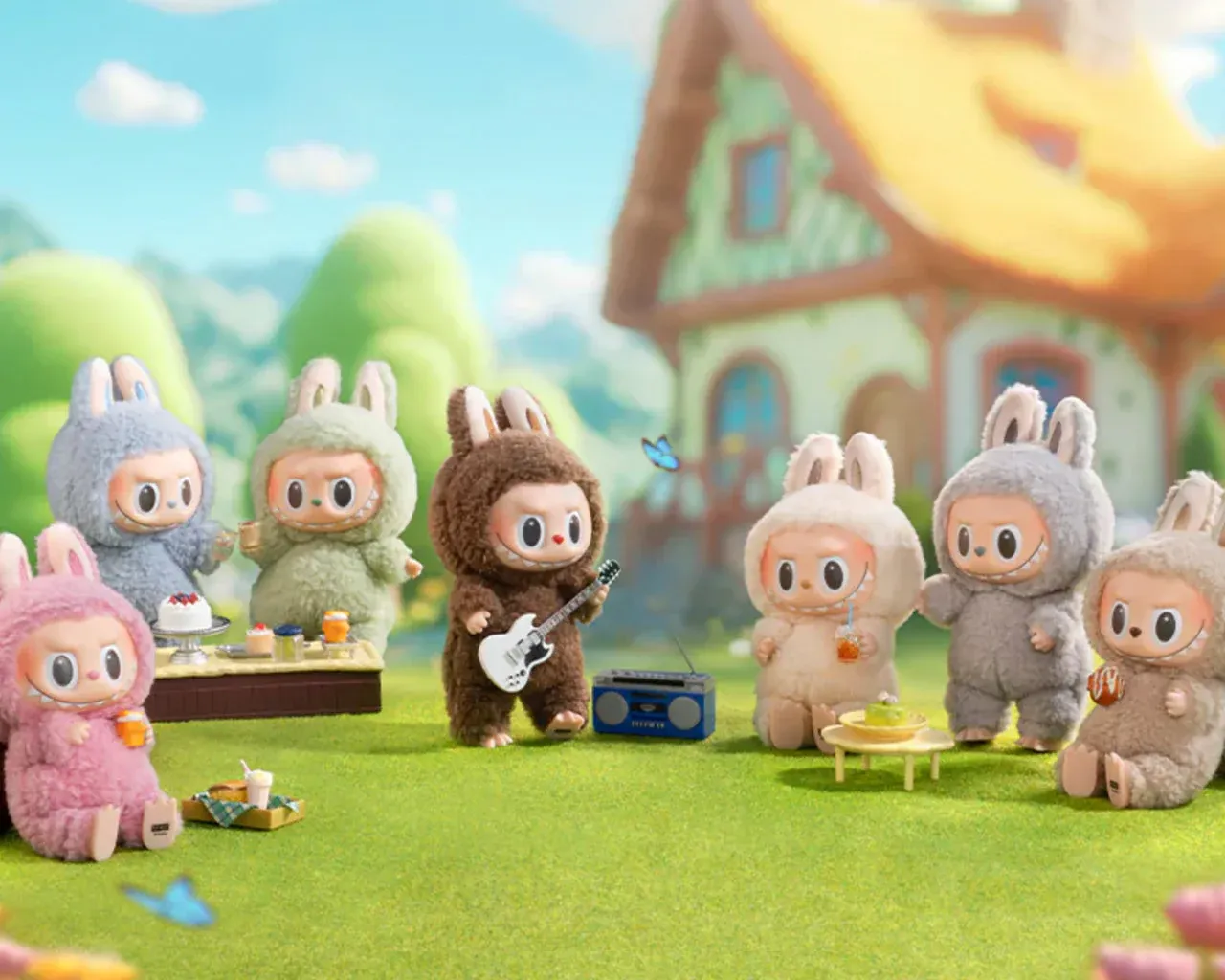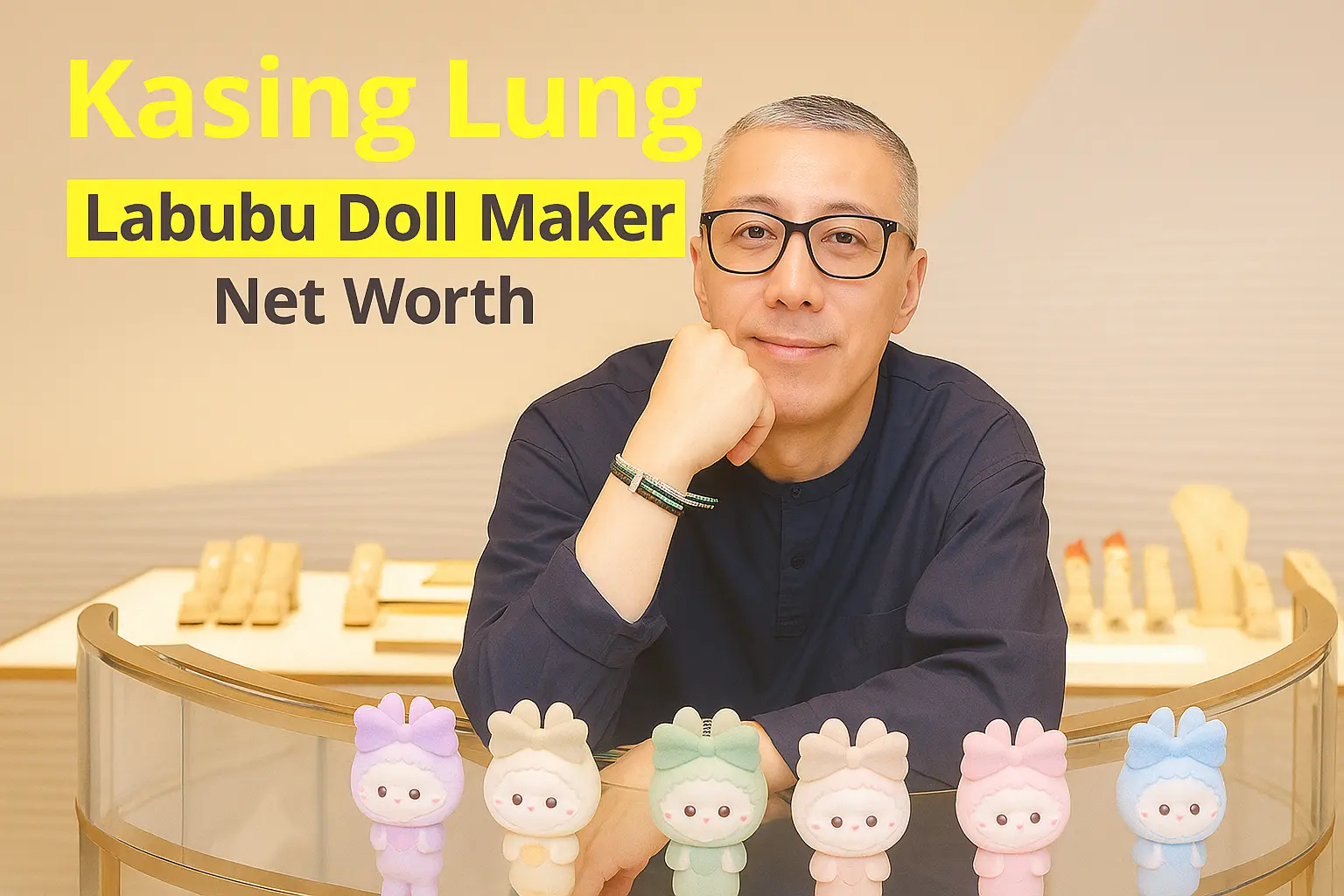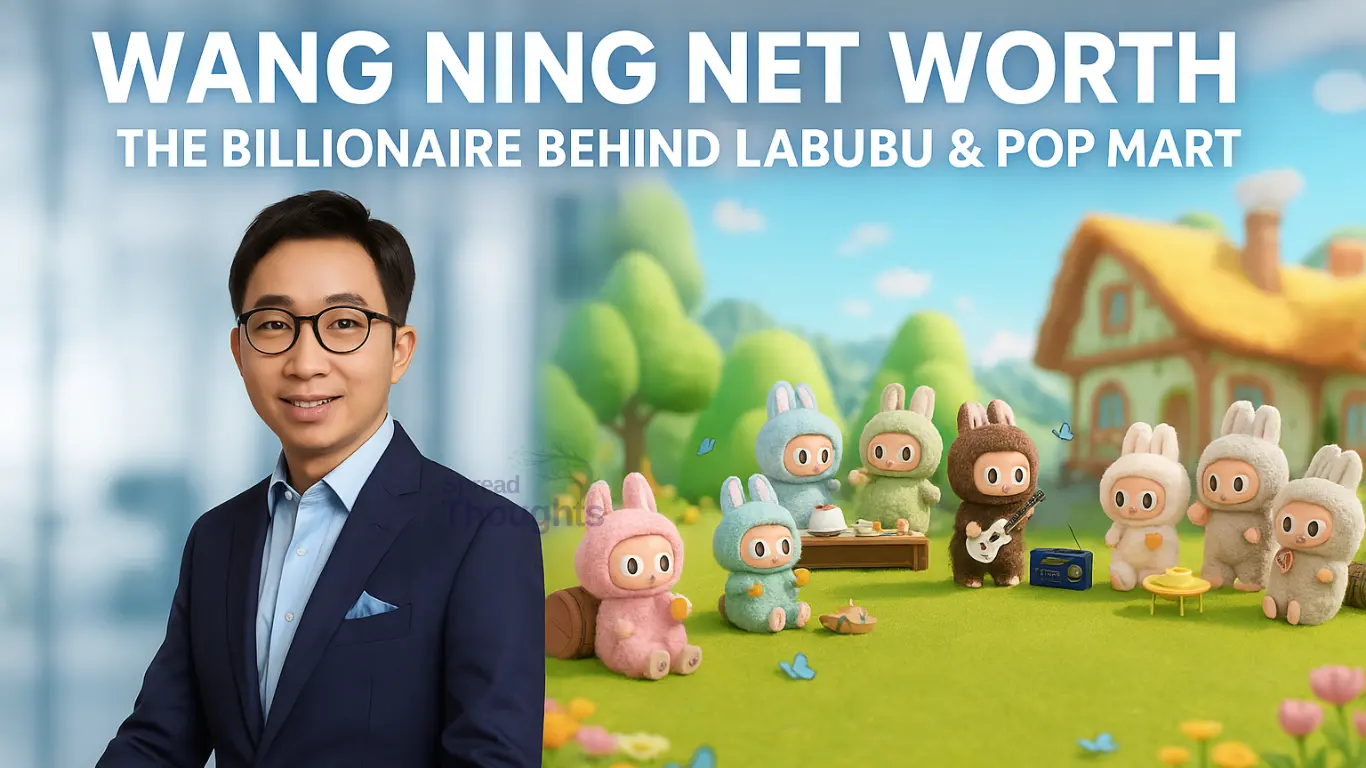Kasing Lung is a household name among designer toy collectors for his hit Labubu. His work combines emotion, storytelling, and stylized character design that resonates with fans in Asia, Europe, and beyond. But who is Kasing Lung? And how much has he made from this global phenomenon? The demand for Labubu and Kasing Lung’s work has gone global and attracted collectors from all over the world.
In this article, we’ll go through Kasing Lung’s bio, the rise of Labubu, his income sources, and estimate his 2025 net worth. Whether you’re a collector or a toy art fan, this is your inside look at the man behind one of the most popular designer figures today.
Who Is Kasing Lung?
Kasing Lung is a Hong Kong-born illustrator and artist living in the Netherlands. He started his career as a children’s book illustrator and has worked on many projects that combine narrative and visual storytelling. His background as a picture book artist laid the foundation for his later success, and he has published several notable books in the Chinese illustration book market, including ‘My Little Planet’. He rose to global fame through the world of designer toys, most notably for creating Labubu, the mischievous little creature with big eyes, sharp teeth, and an expressive personality.
Lung’s style is a mix of dark fairytale and childlike wonder; his creations are emotionally deep and visually unique. He quickly built a fanbase through art exhibitions, toy releases, and high-profile collaborations. He has always been fascinated with toys and illustration since he was a child, and his books and toys are for children and collectors.
Lung the Artist Behind Labubu: Early Life and Background
The creator of the trending doll Labubu came into the world in 1972 in Hong Kong. Since a very young age, Lung was mesmerized by the enchanting world of sketching dolls and painting folktales, and often used to incorporate his imagination by just using a pen and paper. In his early years, his parents would recite to him stories of ancient European elf legends and other classic folktales, developing a keen interest in this captivating world of magical creatures and whimsical creatures.
Lung moved to the Netherlands with his family, eventually adapting to a new culture that enhanced his creativity. Unlike other young lads of his age, he did not indulge in gaming or other modern technology gadgets; instead, he spent hours bringing his vision into reality through sketching, painting, and inventing a creative world. His imaginary creatures often featured serrated teeth, sharp ears, and naughty grins, traits that would become the trademark of his famous creations in the future.
Lung developed a great passion for art in his early days, with continuous motivation from his family. He was much influenced by the emotional depth and playful mischief in the folktales and legends. The early exposure to these stories and artistic traditions laid the foundation for his distinct style. He was known for merging Eastern and Western influences into a unique brand of collectible toys and figures.
The Rise of Labubu and His Global Impact

Labubu started as a sketch in Kasing Lung’s, sketchbooks and made its debut through the toy company Pop Mart, a big name in Asian toy culture. Its weirdness and emotional backstory made it stand out among other designer toys.
Labubu is a popular character in the designer toy world, and its cute design, small and expressive, makes it super popular. Within a few years, doll figurines became bestsellers across Asia, especially in China, Japan, and Taiwan, often selling out in a day. This crazy global demand made Labubu a cultural icon among designer toy collectors.
Doll influence goes beyond toys. The character now appears in exhibitions, licensed merchandise, digital art NFTs, and even events. Its mix of darkness, innocence and emotional storytelling resonates with a generation of collectors who want more than just aesthetics; they want narrative and connection.
Labubu is recognizable by its pointed ears, wide eyes, and serrated teeth, which form a mischievous smile or sometimes a devilish grin. These features are Lung’s signature style and have become iconic in the designer toy community. The character’s popularity is also boosted by high profile endorsements, Blackpink’s Lisa, who helped bring the doll to the masses by posting the toys on social media.
Pop Mart’s global strategy and influence in the collectible toy market have played a big role in Doll Art's success. The company’s innovative approach to marketing and distribution has driven the demand for Labubu figurines worldwide. Pop Mart’s stores in major cities like Paris, Shanghai, and New York (York) are the hub for the global collector community, offering a unique retail experience and exclusive releases that solidify the brand’s international presence.
Revenue Streams: Art Toys, Collabs, and Auctions
So, where does Kasing Lung get his money from?
Here are his main revenue streams:
- Art Toys:
Through partnerships with Pop Mart and other platforms, Kasing releases regular collections of dolls, blind box sets, to rare editions. They sell out fast and get resold on marketplaces for premium prices. - Collabs & Licensing:
He collaborates with brands for limited-edition releases, gallery shows, and exclusive art pieces. These include apparel lines, special packaging, and seasonal releases (e.g., Christmas, Lunar New Year editions). - Art Auctions:
Original sculptures and large-format art pieces have been sold at auctions and gallery exhibitions for thousands of dollars. - Merch & NFTs:
Kasing has also released NFTs and merchandise lines, pins, posters, apparel, and more, adding to his income.
The Pop Mart partnership is huge. The Pop Mart store network has helped push dolls to new heights, leveraging the company’s vast distribution channels and marketing muscle. The collectible figures are often sold in blind boxes, creating hype and exclusivity that drives high demand worldwide among fans and collectors.
The Artist's Kasing Lung Net Worth 2025
It’s hard to estimate Kasing Lung’s net worth because there’s not much public data on his income, and Pop Mart plays a big role in commercializing Labubu. Unlike Pop Mart’s CEO Wang Ning whose net worth is estimated to be $22.7 billion due to his company stake, Lung’s wealth mainly comes from licensing deals, royalties and art sales.
Licensing and Royalties: As the creator of Labubu, Lung gets a percentage of the sales from Pop Mart’s Monsters collection. With the collection making $870 million in the first half of 2024, even a conservative 5-10% royalty rate could be $43.5–$87 million annually, but this is split among many expenses and stakeholders.
Art and Auction Sales: Lung’s art and rare figures like the $42,000 “Mon” artwork and high-value auctioned Labubu figures, contribute a lot. He’s consistently in high-profile auctions, so his annual art income is in the low millions.
Other Ventures: His exhibitions, book sales, and brand collaborations add to his income, but these are less quantifiable.
Based on these, Kasing Lung’s net worth in 2025 is conservatively estimated to be $10–$50 million. This is from his royalties from Pop Mart’s massive Labubu sales, auction proceeds, and other art-related income, but this is speculative without direct financial disclosure. For comparison, Wang Ning’s wealth increased by $8 billion from 2024 to 2025 due to Pop Mart’s success, with a big chunk of it happening in a single day when Pop Mart’s shares skyrocketed, showing the huge gap between the artist and the corporate beneficiary.
Comparisons with Other Designer Toy Artists
|
Artist |
Known For |
Estimated Net Worth |
|
Kaws |
Companion, BFF |
$100M+ |
|
Takashi Murakami |
Superflat Art, KaiKai KiKi |
$50M+ |
|
Kasing Lung |
Labubu |
~$5M–$8M |
While Kasing operates in a smaller but super loyal market, his creativity, storytelling, and emotional connection with fans give him an edge over mainstream pop-art giants.
Final Thoughts: Art, Fame, and Legacy
Kasing Lung’s journey is a reminder that art can be collectible, emotional, and culturally relevant even in the form of a small toy. Labubu’s global appeal, limited availability, and evolving backstory have helped Kasing build not just a brand but a legacy.
As the designer toy space grows, Kasing is set to become a generational icon in this movement. And for collectors, fans, or artists alike, Kasing Lung Labubu story is both inspiring and financially interesting.
FAQs
What is the value of the Labubu company?
Labubu is a brand marketed by Pop Mart, a major collectible toy company. Pop Mart’s sales from the Monsters series, including Labubu, reached around $870 million in the first half of 2024. That’s a big number.
How much does the creator of Labubu earn?
Kasing Lung earns from licensing royalties, art sales, and collaborations. Exact figures are not public, but estimates put his net worth between $10 million $50 million as of 2025, mainly due to Labubu’s global success.
Why is the Labubu doll so expensive?
Labubu dolls are expensive because of limited editions, high demand, collectible status, and the artistic value behind each design. Rare figures and large-sized editions can command premium prices in the secondary market and auctions.
How much is an authentic Labubu doll?
Prices vary. Small vinyl figures start at $15, limited or large “mega” editions can be hundreds or even thousands of dollars. Rare auctioned pieces have sold for over $170,000.
What inspired Kasing Lung to create Labubu?
Kasing was inspired by Nordic and Celtic folklore, childhood fairy tales, and his love for storytelling and illustration. Labubu is a reflection of that with its mischievous grin and whimsical design.
Who are the characters in The Monsters created by Kasing Lung?
The Monsters are Labubu and other characters like Zimomo, Tycoco, Spooky, and Pato. They are a whimsical group with distinct personalities inspired by folklore.
Can you provide a bio of Kasing Lung?
Kasing is a Hong Kong born artist born in 1972 who grew up in the Netherlands. He started as a children’s book illustrator, won the Illustration Award in Belgium and later became famous for creating Labubu and The Monsters, blending folklore with emotional storytelling.
Who is the artist behind Labubu?
The artist of the doll is Lung, a Hong Kong born illustrator and toy designer.
What is the origin of Labubu?
Labubu was born in 2015 as part of Kasing Lung’s series The Monsters, inspired by Nordic and Celtic folklore and childhood fairy tales.
Is Labubu Korean or Chinese?
Doll is a Chinese creation designed by Kasing, who is from Hong Kong. The character is marketed mainly through the Chinese company Pop Mart.
Why did Labubu suddenly become popular?
Labubu’s popularity grew due to its unique design, emotional storytelling, Pop Mart’s marketing, and celebrity endorsements, and created a global collector craze.
Which Labubu figure is the most valuable?
Rare large editions and exclusive auction pieces like a 4ft tall mint-green Labubu sold for $170,000 are the most valuable among collectors.
What is Kasing Lung’s nationality?
Kasing Lung is Chinese, born in Hong Kong, and has strong cultural ties to Europe due to his upbringing and work in the Netherlands and Belgium.













